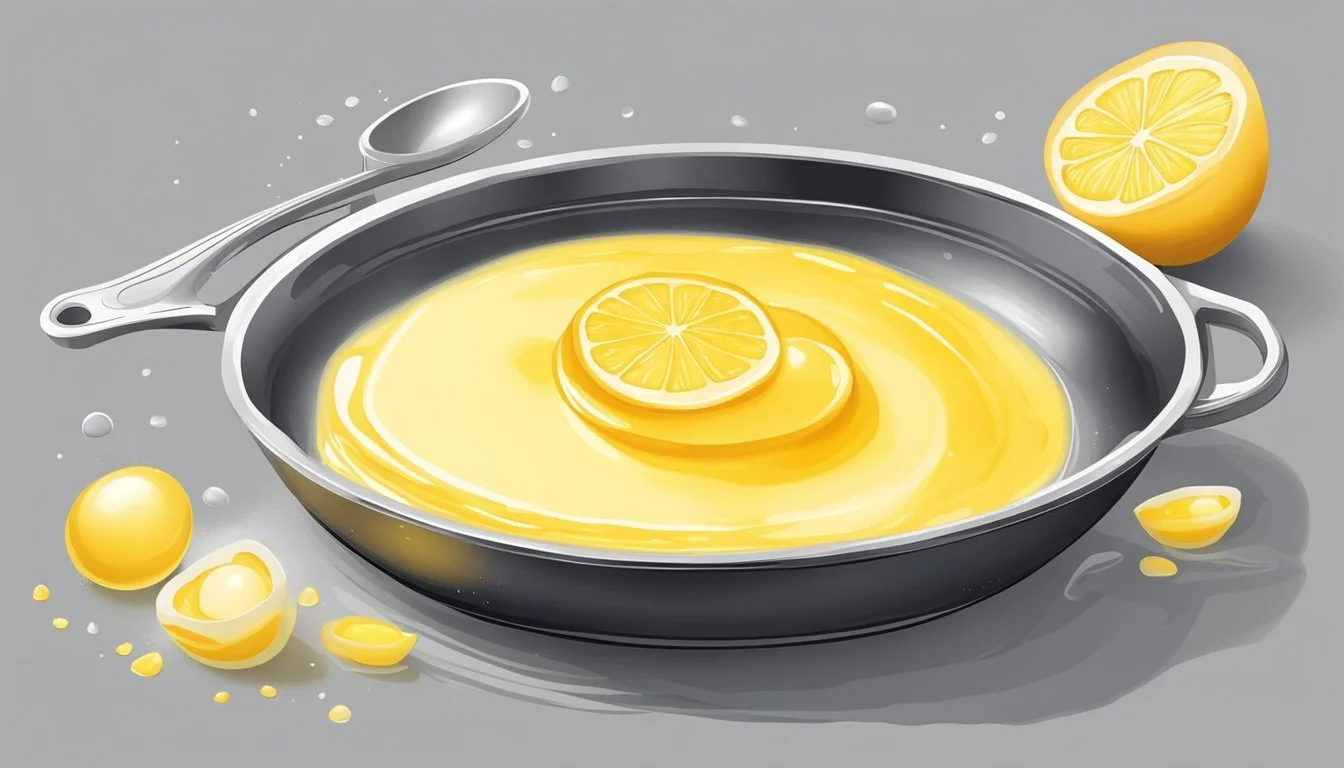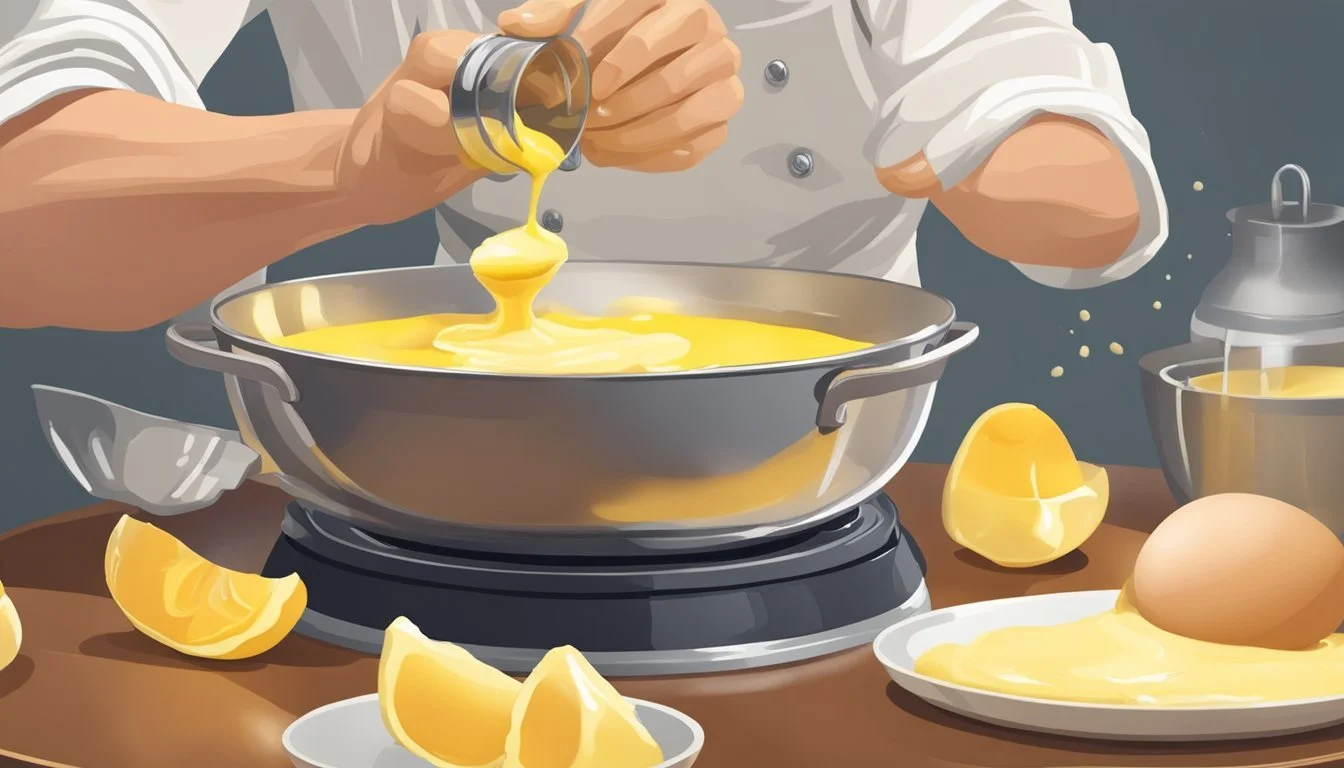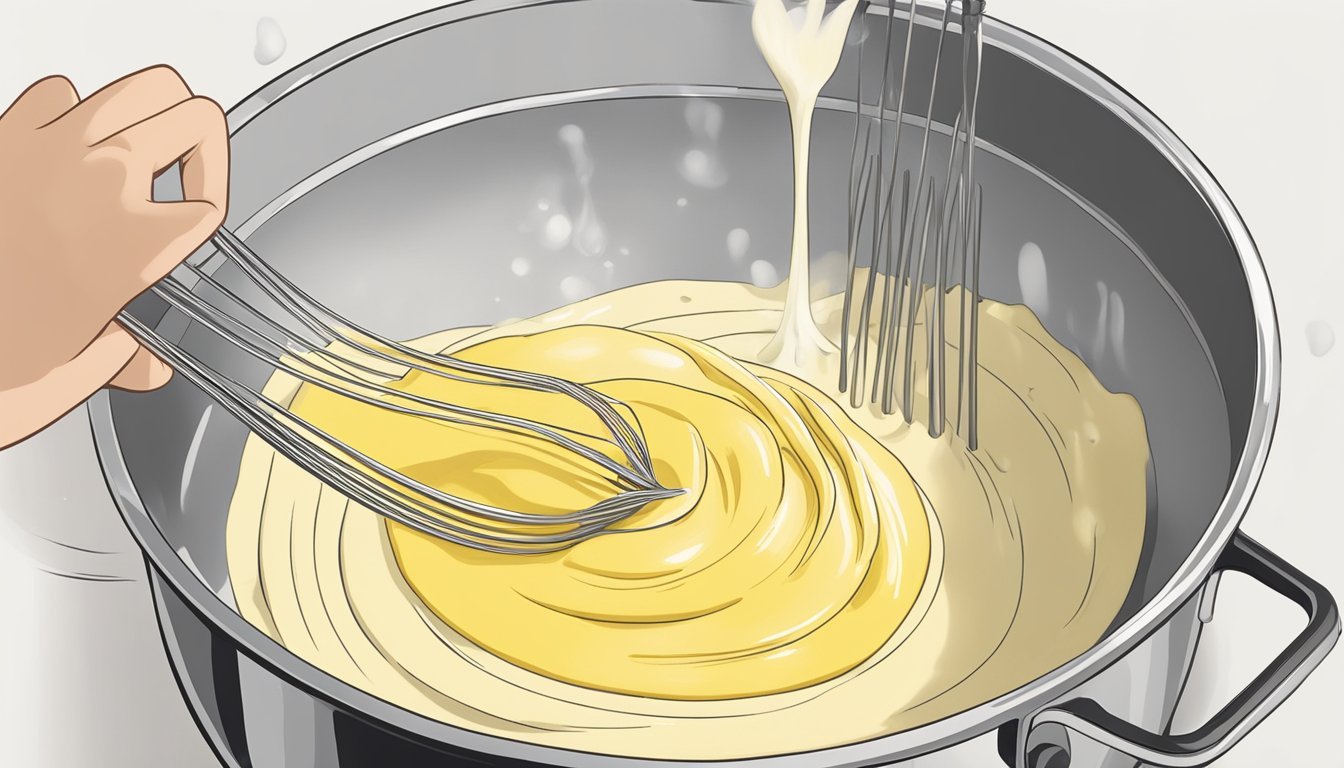Fixing Watery Hollandaise Sauce
Master Thickening Techniques for the Perfect Eggs Benedict
Hollandaise sauce, a staple of classic French cuisine, has become synonymous with the beloved breakfast dish Eggs Benedict. Characterized by its rich, creamy texture and delicate balance of flavors from butter, egg yolks, and lemon juice, the sauce's emulsification is key to its success. However, even seasoned cooks can sometimes find themselves with a hollandaise that is too runny, failing to cling to the perfectly poached eggs and toasted English muffins of Eggs Benedict. The intricacies of hollandaise sauce demand a gentle touch, and when it turns watery, it requires swift and effective measures to restore its desired consistency without compromising its flavor or velvety texture.
When a hollandaise sauce goes awry, there are several tried-and-true thickening techniques that can rescue it. It's essential to understand that overcorrection can lead to separation or curdling, so a careful approach is paramount. Techniques range from incorporating additional emulsifiers, like butter, in a precise manner to using thickeners such as a cornstarch slurry. These methods aim to thicken the sauce while maintaining its smoothness and signature tang. Being equipped with the knowledge of how to correct a watery hollandaise can turn potential kitchen frustration into a display of culinary dexterity, ensuring that Eggs Benedict reaches the table in its best form.
The journey to perfecting Eggs Benedict is a testament to the importance of technique and timing when it comes to hollandaise sauce. Whether it's a matter of tweaking the recipe or employing a smart save when faced with a too-thin sauce, the solutions are within reach. Understanding the properties that contribute to the sauce's structure and the reactions that occur during the cooking process underpins the success of these thickening tactics. With a repertoire of solutions for fixing a watery hollandaise, chefs and home cooks alike can serve up an impeccably prepared Eggs Benedict with confidence.
Understanding Hollandaise Sauce
Hollandaise sauce is a classic emulsion of egg yolks, melted butter, and lemon juice, known for its creamy texture and rich flavor. This section will explore its composition, common issues during preparation, and recommended tools for achieving the perfect consistency.
Composition and Characteristics
The primary ingredients of hollandaise sauce include:
Egg yolks: Provide emulsifying properties and a creamy texture.
Butter: Adds a buttery flavor and contributes to the sauce's velvety consistency.
Lemon juice: Offers a tangy flavor that balances the richness of the butter and egg yolks.
The ideal hollandaise sauce has a thick, creamy consistency, which is achieved through careful temperature control and emulsification.
Common Issues and Solutions
Making hollandaise sauce can sometimes lead to:
Watery Texture: To thicken, try adding an additional egg yolk while whisking constantly over low heat.
Separation: If the sauce begins to separate, whisk vigorously to re-emulsify or start a fresh emulsion with an egg yolk and slowly whisk in the separated sauce.
Temperature control is crucial; overheating can cause the egg yolks to scramble, while insufficient heat may prevent the sauce from thickening properly.
Tools and Equipment
For successful preparation, consider using:
Whisk/Bowl: A whisk and heatproof bowl are essential for combining and emulsifying the ingredients, usually over a pot of simmering water (double boiler).
Saucepan: For stovetop preparation, a saucepan can be used with low and controlled heat.
Blender/Microwave: For a quick fix, a blender or microwave can be employed with caution to avoid overheating and splitting the sauce.
Using the right tools can prevent common issues like separation or inadequate consistency, ensuring a smooth and creamy hollandaise sauce.
Preparation Techniques
Perfecting hollandaise sauce involves careful attention to preparation methods. A blend of rich ingredients like butter and egg yolks, combined with acidity from lemon juice, results in the sauce's desired velvety texture. Mastery of whisking, appliance use, temperature control, and consistency adjustment is essential.
Traditional Whisking Method
The cornerstone of making hollandaise sauce is the traditional whisking method. Cooks begin with a simmering water bath, known as a bain-marie, where a heatproof bowl containing the egg yolks and a bit of lemon juice is placed. To form an emulsion, they continuously whisk as they gradually incorporate melted butter. This motion allows the ingredients to blend smoothly, thickening to the proper texture without separating.
Using Modern Appliances
In contemporary settings, making hollandaise can be expedited with appliances. A blender offers a more hands-off approach by blending the egg yolks and lemon juice before slowly adding hot butter to create the emulsion. Another method involves carefully using a microwave to warm the ingredients, whisking between short intervals to avoid overheating.
Temperature Control
Regulating temperature is a crucial variable in hollandaise preparation. The sauce needs gentle heat to thicken, typically just below simmering. Too high heat can cause the eggs to scramble, while too low won't allow the sauce to thicken properly. Monitoring for a temperature that's just enough to cook but not enough to boil is vital.
Adjusting Consistency
Achieving and maintaining the right consistency is pivotal. If a sauce turns watery, it can be rescued. The introduction of a thickening agent, such as a starch—for example, cornstarch, flour, rice flour, or tapioca—can help. These should be mixed with water to form a slurry before integrating into the sauce. Additionally, kneaded butter (a paste of equal parts soft butter and flour) can be whisked in to correct the texture. Gradual addition is key to avoid over-thickening.
Key Ingredients and Ratios
Achieving the perfect hollandaise sauce hinges on using precise ingredient ratios and high-quality components. This balance ensures a velvety texture and the right flavor for topping classic dishes like Eggs Benedict.
Importance of Ratios
In hollandaise sauce preparation, the ratio of egg yolks to butter is critical. A standard recipe typically calls for:
3 egg yolks
1 cup (225 grams) of unsalted butter
If the sauce is too thin, altering the ratio by increasing the number of egg yolks or decreasing the butter can help achieve the desired consistency. Maintaining this ratio is essential for the sauce to emulsify properly, creating a thick and creamy result without separation.
Quality of Ingredients
The quality of ingredients in hollandaise sauce cannot be overstated. For the best results:
Choose fresh, high-quality egg yolks for a smooth foundation.
Opt for high-grade unsalted butter, which allows for better control over the sauce’s saltiness.
Fresh lemon juice is preferred over bottled for its brightness and acidity.
The freshness and quality of ingredients significantly affect not only the stability of the sauce but also its flavor and richness.
Seasoning Adjustments
Proper seasoning is crucial for enhancing the sauce and should be tailored to the dish it accompanies. Common seasonings include:
A pinch of salt to enhance overall flavor.
Black pepper or cayenne for a slight heat.
Lemon juice or vinegar for acidity, balancing the richness.
Optional spices like paprika or fresh herbs like chives and parsley can be added for complexity and visual appeal.
Season gradually and taste frequently, ensuring that the hollandaise complements rather than overpowers the dish it's served with.
Assembly of Eggs Benedict
The assembly of Eggs Benedict is a precise process that layers poached eggs with other ingredients atop an English muffin, all topped with velvety hollandaise sauce. Correct techniques ensure each component comes together harmoniously for a classic brunch (What wine goes well with brunch?) dish.
Poaching the Perfect Egg
For poached eggs with firm whites and creamy yolks, bring a saucepan filled with water and a tablespoon of white vinegar to a gentle simmer. Crack each egg into a separate small bowl. Gently pour the eggs one at a time into the water, cooking for 3 to 4 minutes.
Layering the Ingredients
Start with a toasted English muffin as the base and add a slice of warm Canadian bacon or ham. Carefully place the poached egg on top of this meat layer, ensuring not to break the yolk. It's crucial that the other elements are prepared and warm, ready to receive the egg.
Final Touches and Plating
Generously pour the thickened hollandaise sauce over the poached egg. The sauce should envelop the egg and touch the layers beneath, creating a rich and cohesive dish.
Serving Suggestions
Eggs Benedict is traditionally served as a hearty breakfast or brunch option. The dish pairs well with sides of asparagus or lightly dressed greens for a fresh contrast to the indulgent hollandaise.
Alternative Eggs Benedict Variations
Variation Substitute Eggs Florentine Spinach instead of bacon/ham Avocado Toast Benedict Fresh avocado slices Smoked Salmon Benedict Smoked salmon in place of ham Crab (What wine goes well with crab?) Cake Benedict Crab cakes (What wine goes well with crab cakes?) as a base Tomato-Topped Benedict Slice of tomato added to the stack
These alternatives cater to different dietary preferences while still encapsulating the essence of classic Eggs Benedict.
Troubleshooting and Fixes
When preparing hollandaise sauce, achieving the ideal texture and consistency is vital. This section provides practical solutions for addressing a watery sauce and preventing as well as correcting any separation that might occur.
Addressing Watery Sauce
A watery hollandaise can jeopardize the lusciousness of Eggs Benedict. To thicken the sauce, chefs can employ various methods:
Slurry: Whisk a slurry of starch, such as cornstarch or flour, into the sauce. A 1:1 mixture of flour and water or a spoonful of cornstarch with equal parts water will do the job. Start with a small amount of slurry, adding it gradually to avoid over-thickening.
Additional Egg Yolks: Gently whisk in an additional yolk or two, making sure they're tempered to avoid cooking them on contact.
Butter: Incorporate cold, kneaded butter in small pieces. The cold butter will melt slowly, lending its fat to thicken the sauce.
One should introduce these thickening agents gradually, assessing consistency between additions, to avoid making the hollandaise too thick.
Preventing and Correcting Separation
The stability of hollandaise rests on maintaining its delicate emulsion.
Temperature Control: It's crucial to manage temperature. Excessive heat can cause the sauce to separate. If this occurs, remove the sauce from the heat source immediately and place it in a room temperature bowl.
Whisk Vigorously: If separation begins, vigorous whisking can help reintegrate the emulsion. Sometimes, a few droplets of cold water may aid in bringing back the smooth texture.
Caution with Additives: When adding any thickening agent, it's important to whisk continuously to ensure the additive integrates smoothly, preserving the sauce's velvety texture.
Above all, maintain a careful eye and a steady hand when incorporating any fix to the sauce, keeping both texture and stability in mind.
Storing and Reusing Hollandaise Sauce
Proper storage and reheating techniques are essential for hollandaise sauce to maintain its consistency and flavor. When handled with care, leftover sauce can be a delicious accompaniment to many dishes beyond the classic Eggs Benedict.
Proper Storage Techniques
To store homemade hollandaise sauce, one must let it cool to room temperature to prevent condensation before refrigerating. Store it in an airtight container for up to one day. For store-bought hollandaise, follow the manufacturer’s guidelines, typically keeping it in its original jar, sealed tightly, and refrigerated.
Reheating Without Spoiling
Reheating hollandaise sauce requires a gentle touch to avoid separation. Heat the sauce using a double boiler on low heat, constantly stirring to maintain a smooth texture. Alternatively, place the sauce in a microwave-safe bowl, and microwave at 50% power in short intervals, stirring between each to prevent overheating and splitting.
Utilizing Leftover Sauce
Leftover hollandaise sauce can bring new life to vegetables like asparagus or proteins such as chicken. Lightly drizzle the reheated sauce over steamed vegetables, poached fish, or use it to enhance a simple sandwich with tomato and avocado.
Making Advance Preparations
One can make hollandaise sauce in advance by preparing it to the point just before thickening agents, like butter, are added. When ready to serve, reheat the base to the appropriate temperature and whisk in warm melted butter to achieve the desired consistency and flavor.
Additional Tips and Variations
When perfecting hollandaise sauce, a chef must consider the balance between texture and flavor. This section provides guidance on introducing new flavors, exploring healthier options, and adapting the classic hollandaise into related sauces.
Incorporating Unique Flavors
A classic hollandaise sauce consists primarily of butter, egg yolks, lemon juice, and a touch of cayenne pepper. However, one can introduce an array of unique flavors without compromising the sauce's velvety texture. For an aromatic twist, infuse the butter with shallots, fresh herbs, or cracked black pepper before emulsifying it with the egg yolks. To add depth, a splash of white wine can be reduced and incorporated into the sauce. Other citrus juices like lime or orange can replace lemon for a varied taste.
Healthy Alternatives and Substitutes
Health-conscious cooks can make hollandaise sauce lighter by substituting ingredients. Instead of using all butter, they can blend in puréed avocado for a creamy texture and a boost of healthy fats. Thick Greek yogurt or low-fat cream could partially replace butter to lower the sauce's overall fat content. Additionally, using more lemon juice and adding spices like cayenne pepper or fresh herbs enhance the flavor without extra calories.
Creating Related Sauces
Hollandaise sauce serves as a base for several related sauces, each distinguished by unique additions. To transform it into Béarnaise sauce, one includes a reduction of white wine, shallots, chervil, tarragon, and sometimes chives. This modification pairs excellently with steak and asparagus. Similarly, adding tomato purée creates a Sauce Choron, offering a tangy twist suitable for eggs Benedict or vegetable dishes. Adjusting the hollandaise by introducing different seasonings and herbs enables chefs to craft a variety of sauces to suit multiple dishes and palates.
Conclusion
Achieving the perfect consistency in homemade hollandaise sauce—a cornerstone of classic breakfast recipes like eggs benedict—requires precision and care. This guide has outlined reliable techniques to rescue a watery sauce, preserving the luxurious texture and rich flavor that egg recipes are celebrated for.
Butter Addition: Integrating cold, kneaded butter enriches the sauce, enhancing its thickness.
Cornstarch Slurry: A careful blend of cornstarch and water, added bit by bit, provides control over the thickening process.
Egg Yolks: Introducing additional egg yolks into the sauce can fortify its structure, leveraging their natural thickening properties.
Roux Application: A mixture of butter and flour, cooked into a roux, then gradually whisked into the sauce, delivers a classic thickening method.
A successful hollandaise sauce embodies a balance of flavor and texture. Whether preparing for a family breakfast or crafting an eggs benedict for a special brunch, these thickening techniques are pivotal for any culinary enthusiast. The methods discussed are not just steps but pillars of knowledge, supporting the journey to perfect the art of sauce making.
Each approach warrants attention to detail and a light hand, ensuring that the final product not only satisfies but also delights. With practice, these tips will become second nature, inviting one to explore and perfect other culinary endeavors. The knowledge imparted by this guide aims to boost confidence, equipping readers with the finesse needed to master the development of a robust hollandaise sauce for their next homemade breakfast triumph.






